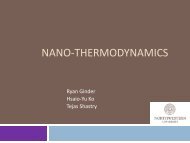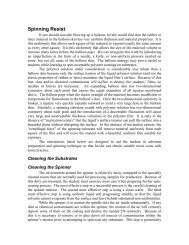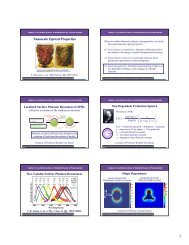A Practical Guide to SPM
A Practical Guide to SPM
A Practical Guide to SPM
You also want an ePaper? Increase the reach of your titles
YUMPU automatically turns print PDFs into web optimized ePapers that Google loves.
18<br />
surface in contact AFM imaging. Soon, this technique proliferated and<br />
then matured as a separate investigation method. Force spectroscopy<br />
can also be used <strong>to</strong> analyze the adhesion of surface contaminants, as<br />
well as local variations in the elastic properties. Other configurations<br />
are also used. For example, at a given X,Y location, and a given tipsample<br />
separation in Z, a bias can be applied and ramped between<br />
the sample and the tip so that the cantilever deflection is measured in<br />
response <strong>to</strong> the electrical interaction between the tip and the sample.<br />
A force vs. distance curve is a plot of the deflection of the cantilever<br />
versus the extension of the piezoelectric scanner that changes the<br />
distance between the sample and the tip. Contaminants and lubricants<br />
affect force spectroscopy measurements, as do thin layers of<br />
adsorbates on the sample surface.<br />
Force<br />
In the labora<strong>to</strong>ry, force-distance curves are quite complex and specific<br />
<strong>to</strong> the given system under study. The graphics here represent a<br />
simplification — the shapes, sizes, and distances are not <strong>to</strong> scale.<br />
a<br />
b<br />
Distance<br />
Sample<br />
Force<br />
Sample<br />
b<br />
Consider the simplest case of an AFM in vacuum. At the <strong>to</strong>p of Figure<br />
6-1, on the left side of the curve, the scanner is fully retracted and the<br />
cantilever is un-deflected, as the tip and sample are far apart. As the<br />
scanner extends, closing the tip-sample gap, the cantilever remains<br />
un-deflected until the tip comes close enough <strong>to</strong> the sample surface <strong>to</strong><br />
experience the attractive van der Waals force. The cantilever bends<br />
slightly <strong>to</strong>wards the surface and then the tip snaps in<strong>to</strong> the surface<br />
(point a).<br />
Distance<br />
Water<br />
c<br />
As the scanner continues <strong>to</strong> extend, the cantilever deflects, being<br />
pushed by the surface (region b). After full extension of the scanner, at<br />
the extreme right of the plot, the scanner begins <strong>to</strong> retract. The<br />
cantilever deflection retraces the same curve, in the reverse direction.<br />
d2<br />
d<br />
c2<br />
d1<br />
c<br />
c1<br />
Force<br />
Sample<br />
Distance<br />
Sample<br />
Lube<br />
Lube<br />
Figure 6-1. Force vs. distance curves in vacuum (<strong>to</strong>p), air<br />
(middle), and air with a contamination layer (bot<strong>to</strong>m).<br />
c1<br />
c2<br />
In air, the retracting curve is often different because a monolayer or a<br />
few monolayers of water are present on many surfaces (Figure 6-1,<br />
middle). This water layer exerts an attractive capillary force on the tip.<br />
As the scanner pulls away from the surface, the water holds the tip in<br />
contact with the surface, bending the cantilever strongly <strong>to</strong>wards the<br />
surface (region c). At some point, the scanner retracts enough so that<br />
the tip snaps free from the surface (point d). As the scanner continues<br />
<strong>to</strong> retract, the cantilever, now free, remains un-deflected.<br />
If a lubrication or contamination layer is present on the sample surface,<br />
multiple tip-snaps can occur (Figure 6-1, bot<strong>to</strong>m). The positions and<br />
amplitudes of the snaps depend upon the adhesion and thickness of<br />
the layers present on the surface.
















